Aful Explorer
Pragmatic Excellence - the best hybrid IEM in the $100-$150 price range?
With the Explorer, AFUL has seamlessly integrated the innovative single BA driver design of the Magic One, known for its resonator chamber technology and exceptional sound fidelity, with the multi-driver hybrid configuration of the Performer series. The promise of this combination should offer both the clarity and precision of best balanced armature drivers and the dynamic range and bass impact of dynamic drivers.
But does the Explorer live up to this promise. Read on to find out.

Introduction
I have been enjoying the explorer for a few weeks and I finally feel like I can share some of my findings.
Note: I would like to thank hifigo.com for providing the Aful Explorer for the purposes of this review. It currently retails for $119 which as you will see is an excellent price for this IEM. If you are interested in more information about the Aful Explorer check it the details on their website and on hifigo
Let’s start to explore what you get in the box.
Unboxing Experience and Box Contents
The unboxing experience of the AFUL Explorer is straightforward and elegant.

Removing the other covering you get a nice understated box:

Upon opening the box, you are immediately greeted by the beautifully designed Explorer IEMs.

The case features a combination of hard and soft materials, with a firm structure on the upper and lower sides and a softer texture around the zipper area.
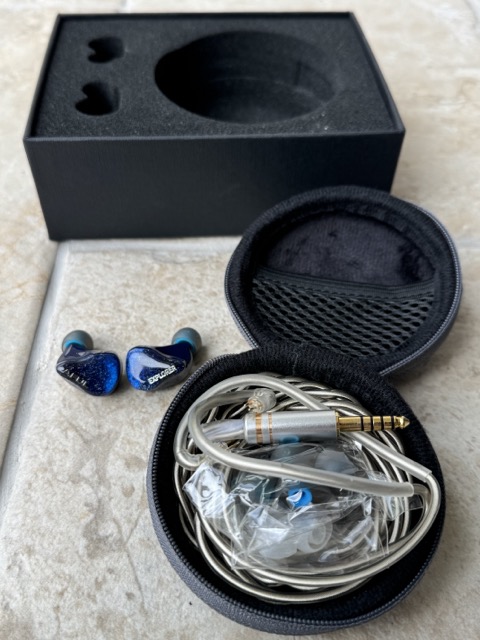
Inside the case, you’ll find the cable of the AFUL Explorer and two sets of silicone ear tips. One set is white and made of white, soft silicone, while the other set is darker in color and made of harder silicone.

While the provided ear tips are functional, I highly recommend using your favorite ear tips for a more comfortable and personalized experience. I used the provided eartips (medium size) for some measurements, but I mainly used my favourite Dunu XL eartips for my listening. Though as I will explain in the listening impressions section I did spend a few days experimenting with different eartips.
I really like the build quality and design of shells - you do get that ‘stars’ in the night sky vibe from these IEMs:

They really are very beautiful shells:
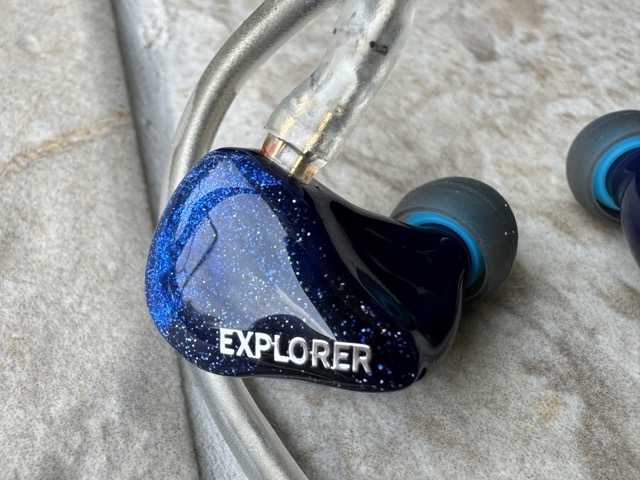
Build Quality and Comfort
The earpieces are ergonomically crafted to provide a very comfortable fit, even during prolonged listening sessions.
I brought the Explorer out with me on numerous long walks, I am doing ‘Camino’ walk across northern Spain again this year, and I am on the lookout for the perfect quality IEM for this walk. Bluetooth TWS sets while they are getting better do not sound as good as a wired IEM and I like to listen in comfort for the 4-5 hours of walking each day.
So I have both getting fit for my trip and also auditioning at the same time in the past week or so. So these are very comfortable. To get a feel for the shape I recorded a few short videos.
Firstly just on their own: And from a different angle:
And finally in comparison with a Truthear Zero Red, which is similar in size but actually feels larger in my ears and where the angle of the nozzle is quiet different than the Explorer. The opinated ’lip’ on the Explorer also works well for me to keep the explorer from ‘moving’ around while I was walking.
I would guess that more people will find the explorer more comfortable than the Zero Red. But it is a large IEM, so for the other extreme, I have shown it with the much smaller Moondrop Chu II in this visual comparison:
One thing you can see in these videos is there is no ‘filter’ covering the nozzle of the Explorer, does this make a difference? Probably not but over time I would recommend make sure to clean the nozzle.
Additionally, the IEM features a vent positioned in the outer corner, strategically placed to prevent contact with the ears and ensure the ears don’t cover the vent.
The resin earpieces’ blue face plates do resemble a galaxy, evoking a stunning visual reminiscent of a starry sky.
Here they are again this time with my Dunu XL eartips (with some ‘custom’ foam embeded for added comfort):

Overall, the AFUL Explorer’s design and construction are not only aesthetically pleasing but also contribute to a comfortable and enjoyable listening experience.
Sound Quality
So I started my listening tests with my usual ‘audiophile’ playlist, and I was immediately very impressed with the sound, in almost all my sample tracks it provided an excellent tonality. But I did notice with some female vocal tracks, for example, “Summertime” by “The Sundays” I felt the singer’s voice was slightly muted other midrange elements of that song.
But let’s get into the details:
Bass
The AFUL Explorer stands out with its impressive bass response, tracks like “Limit of your Love” by James Blake had that deep yet accurate subwoofer bass that can be hard for cheaper IEM’s to produce, on other trackcs like Hunter by Bjork at the 13 second mark the bass kick you get from the Explorer really lifts the overall experience of that song.
The mid-bass of the Explorer is punchy, powerful and delivers a strong slam and most importantly does not over power the midrange and provides a nice balance with the treble.
Midrange
Other than a slight issue with some female vocals I found the midrange to be excellent, in some respects specifically around male vocals and piano and guitars the midrange reminded me of one of my favourite IEM’s from last year the Kiwi Ears Orchestra Lite for that ability to provide slight forwardness which is especially welcome if you listen to lots of pop, rock and acoustic based music.
Treble
The treble for me was very smooth and accurate but never sibilant, I would guess people might call this a ‘boring’ sound and I can imagine some ‘reviewers’ saying the technicalities were not great but in reality the treble had no obviously flaws ( I even listened to some ‘audio sweeps’ to make sure the treble had no peaks or troughs ) and it was excellent.
What this means is if you really want to do a simple EQ of the Treble from the 7K+ up it will take to simple treble EQ “shelf” or just adjusting the treble in your music player to preference will do a nice job. “Over There” by “Japanese House” has some treble “peaks” which can sound a bit harsh on some incorrectly tuned IEM’s but not on the Explorer - I found that track can be a good way to subjectively get the right level of treble adjustment (if that is your preference), e.g. play it a few times adjusting the treble until you are happy and because of the smooth “non-peaky” treble beyond 7K it will be at that appropriate level throughout your listening experience.
Soundstage and Imaging
The Explorer soundstage was good, but you cannot expect miracles with IEM’s, it will sound like its inside your head. The stage isn’t too wide, but just right providing a balanced sense of space and depth that enhances the overall listening experience. The details provided by the accurate treble and the excellent left/right channel matching (as you will see in the measurements) meant I got super accurate placement say while listening to “Fleetwood Mac” “Rumours” album (always a great test of the imaging accuracy IMO), you can imagine the band standing in 3D space in front of you during each song.
Overall, the sound out of the box is excellent and while I did do some tweaks ultimately to the sound profile (mainly using alternative ear-tips) you should not feel like you will need to do this.
Specifications and Measurements
First here at the provided specifications:
- Model: AFUL Explorer
- Impedance: 26Ω ±10%
- Sensitivity: 108dB/mW
- Frequency Response: 10Hz - 30kHz
- Cable Length: 1.2m
- Driver Configuration: 1 Dynamic Driver + 2 Balanced Armatures
- Cable Connector: 2-Pin (0.78mm)
- Cable Termination: 4.4mm Balanced or 3.5mm
- Effective Sound Pressure Level Range: 20 - 108dB
Aful provided a nice diagram of the internal structure of the Explorer:

Frequency Response
^Note: All these measurements (unless otherwise stated) where measured on my 711 Clone coupler using REW. And are available on my IEM measurement database here ^
Let us start with the ‘default’ frequency response with the supplied medium ear tips and compared with the Harman
Adjust IE target:

But let’s get into some ‘Audio nerdy’ analysis.
First thing I noticed was how consistent the left and right channel measurements where. This is something you definitely do not get with sub $100 IEMs. This helps with imaging and overall clarity.
The second thing I noticed was the shortfall between 2K and 8K but this area (more specifically the 2K - 4K region)
is where most people now because the 2019 Harman IE target is wrong and the community believe we will revised target
soon. The ’new’ idea is mostly we have a preference tilt to show how this works lets compare the Explorer with the
‘Truthear Zero Red’ (which is close to a Harman reference):

So you can see the Truthear has less bass and more treble than the Explorer. This is there is now a trend to ’tilt’ the sound signature to be closer to ‘ideal’. This can be very subjective but it’s an interesting trend IMO and from the IEM’s that I have listened to it is a welcome change.
Aful were obviously tuning the Explorer for this ’tilt’ which is relaxed pinna region treble but may
have overshot the mark slightly. To get to the bottom of this, I decided to compare my measurement with 2 of the most
hyped (for their tuning) recent IEM’s in the Moondrop Dusk (specifically the ‘DSP/ USB’ tuning) and the new Dunu
DaVinci. To illustrate this
here is a comparison using data from GizAudio’s Squiq.link (with my Explorer measurements uploaded):
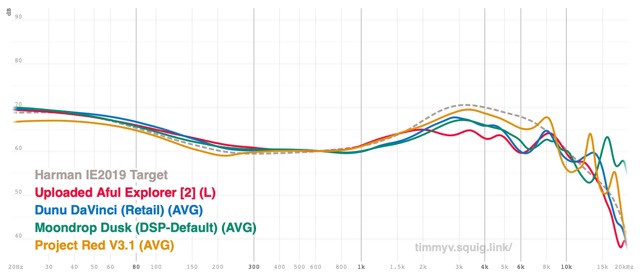
Note: The ‘Project Red’ is the Truthear Zero Red
So hopefully you can see that both of these highly recommended $300+ IEM’s have very similar bass and midrange to the Aful explorer and a similar (though not as dramatic) ‘relaxed’ 2K-8K compared to ‘Harman’ and in this case the Truthear Zero Red.
At this point, I thought the Aful Explorer was good but maybe some EQ, but then I decided to measure some
alternative eartips (since I had subjectively switched to my Dunu XL and some Foam eartips pretty early in my
listening tests) I thought I should measure the difference some eartips make in this specific region:

So this graph shows a lot of key information IMO, firstly with the 3 different eartips I measured the only area that changes is the treble, the bass and midrange are mostly identical. The triple flange was obviously the most dramatic and not recommended unless you want that ‘Harman’ IE boost in this region. The Foam tips on the other hand nicely boosted the treble in the 2K-5K region.
Also, I highlighted a few other things on this graph for a bit of analysis:
- Da Vinci has too much bass - the Aful Explorer has a better bass
- This upper midrange boost is very reminisent of one of my favourite IEM’s from last year the Kiwi Ears Orchestra Lite - I will show a comparison graph in a second
- In this upper treble region, if you want that ‘sparkly’ treble you would to boost (a simple treble shelf will do as the Treble is very smooth on the Explorer with no annoying peaks and no sibiliance issues - it is sort of perfect to allow a smooth treble boost to taste)
So with that midrange comparison with the Kiwi Ears mentioned in 2 above here is a comparison graph:
 The Kiwi ears Orchestra Lite has a similar midrange ‘boost’ between 1K - 2K but continues while the Explorer does
start to recess the treble extension around 2K to bring in more inline with this ’tilt’ as mentioned above.
The Kiwi ears Orchestra Lite has a similar midrange ‘boost’ between 1K - 2K but continues while the Explorer does
start to recess the treble extension around 2K to bring in more inline with this ’tilt’ as mentioned above.
Overall in summary, I think the Frequency response of the Explorer is excellent out of the box, but I would recommend exploring some alternative ear tips like the Foam or maybe a double flange, and then it is a simple treble boost (only if it is your preference), with these tweaks you will get very close to the latest ‘hyped’ tuning, but I should repeat this already excellently tuned ’laided back’ sounding IEM.
If you want some slight EQ this is what I would recommend - not I think it is incorrect to EQ this straight to the
Harman IE 2019 target - but since it is what we have I have shown what I believe ( without doing ear tip rolling ) which would
be the best sounding EQ for this IEM:
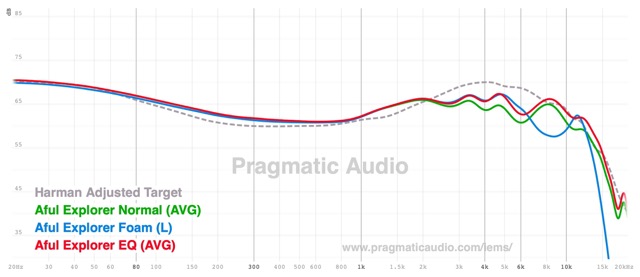
So I am showing the EQ which was applied to the default measurement and not the Foam ear tips. This is 2 simple filters:
Filter 1: ON PK Fc 5000 Hz Gain 3.0 dB Q 1.300 Filter 2: ON HSC Fc 9000 Hz Gain 2.0 dB Q 1.300
And Filter 2 is totally optional and was just a preference of mine.
Finally, let delve into some other measurements which can be important:
Distortion
Distortion is well controlled even at 94 dbSPL - always below audible limits:
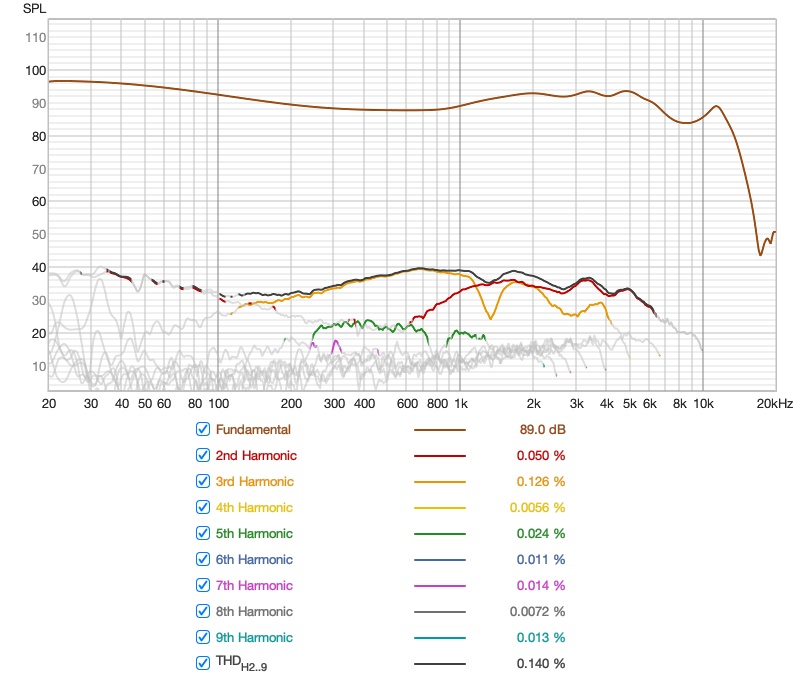
Shown as a %, again it shows nothing to worry about you are getting the music as without any colouring:
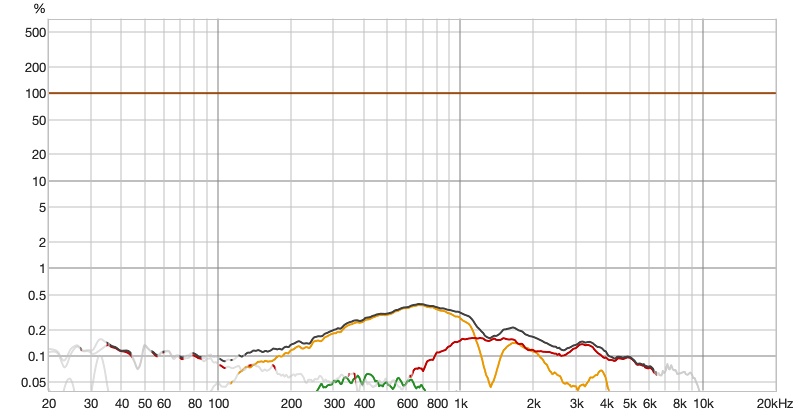
Group Delay
For those interested here is the Group delay showing no problems with any of the internal crossovers between the DD
and the 2 BA’s:

Rating
I have given the Explorer a 5 star pragmatic rating. It is an obvious step up in quality over the sub $100 IEM’s while offering a tuning which is good without any tweaks but is easily adjusted by those who use their own eartips (like myself). Others more used to an Harman tuning might want to some EQ but I do think Aful are moving in the correct direction with the Explorer and I can’t wait to hear that they doing with future models in the Explorer series.
Conclusion
The AFUL Explorer is a standout IEM that offers a unique sound signature that will appeal to a wide range of listeners. With its powerful bass, detailed midrange and a smooth treble region which can be manipulated easily, the Explorer delivers a listening experience that is both engaging and immersive. The impressive build quality, comfortable fit, and thoughtful design further enhances its appeal.
While it may not be perfect (no IEM in this price range is), the Explorer’s combination of advanced technologies and sound quality makes it an excellent choice for anyone seeking a high-performance IEM at a reasonable price. It is a signicant step up in quality over sub $100 IEMs. I highly recommended for its value and sonic performance.